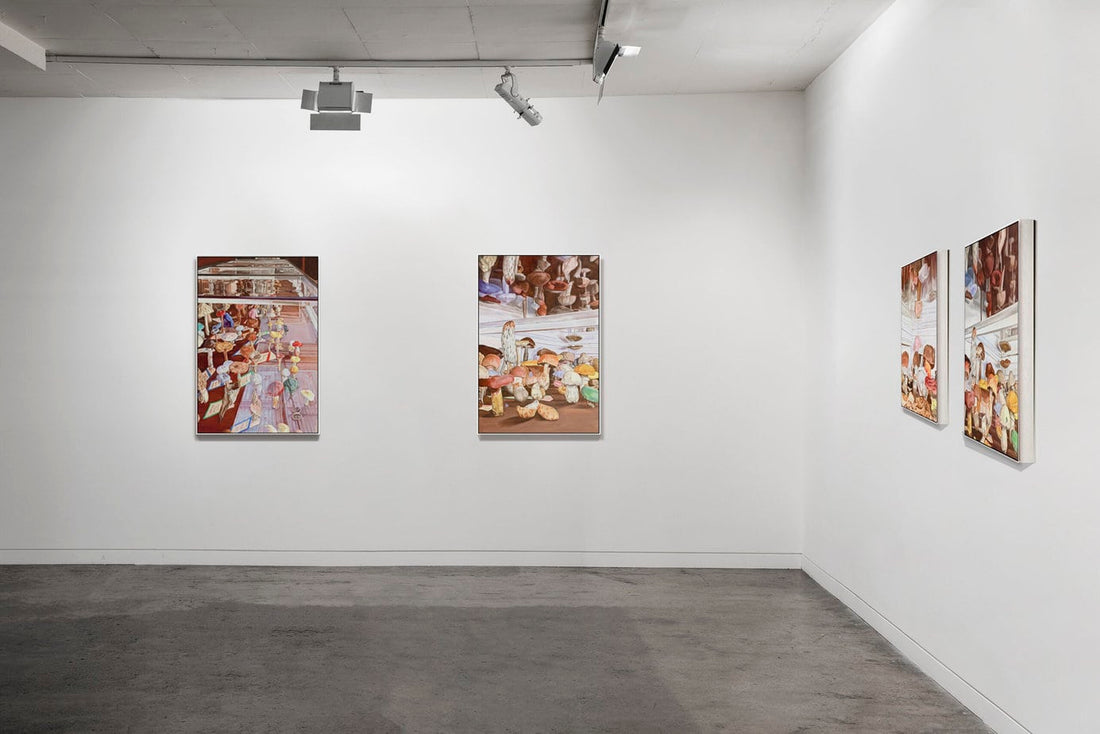NOVEMBER 4, 2022 - DECEMBER 3, 2022
Cabinet of Wonders – and Concern
Dr Saskia Beudel
Dena Kahan’s Wunderkammer exhibition revisits archival sources that have informed her work since 2008 – nineteenth century botanical and zoological models made from glass or papier-mâché. When Kahan was unable to travel during the worst of the COVID-19 pandemic, she journeyed back through her own records of prior research trips to the Whipple Museum of the History of Science at the University of Cambridge, the Royal Botanic Garden Edinburgh and the Santos Museum of Economic Botany (MEB) in Adelaide.
‘There’s no control in a museum. You get what you get,’ Kahan says of her working process. Objects are placed in decades-old arrangements or in states of disarray, which is all part of their appeal. Cropping her photographs to find compositions is an integral part of Kahan’s translation of photographic record to paint. So too is discovering happy accidents within the images – flares of light, bewildering arrays of reflections cast across glass surfaces of museum vitrines, which have long been a fascination in her work.[i]
‘Sometimes I don’t even know what I’m looking at,’ she says. A pale oblong becomes recognisable as a ceiling light or a computer terminal. A series of vertical lines in subtle shades of blue-grey that recall the careful, evocative hand of an Agnes Martin resolve as slivers of sky through an office blind in Museum Still Life with Snail (2021).
Some works portray an eclectic assortment of objects in keeping with the overarching idea of the Wunderkammer or cabinet of curiosities. Tracing back to the Italian Renaissance, these private collections were precursors to the museum,[ii] and brought together idiosyncratic assemblages – fossils, stuffed animals, artefacts from the ‘New World’, a narwhal tusk. In Museum Still Life (2021), segments of chrysanthemum, two earthy-pink mushrooms and a red apple are displayed alongside what could be a portion of a flayed human leg and nameless human parts veined and gilled like their botanical counterparts. The uncertainty of these objects only adds to their intrigue – and wonder.
In Wunderkammer #1 – #6 the subject is unmistakably fungi. The life-like papier-mâché models were crafted by Heinrich Arnoldi & Co in Germany.[iii] Director of the MEB, Richard Schomburgk, acquired the fungi between 1872–1888, labelling them in three categories: ‘edible species in blue, poisonous in red and harmless in green’ – knowledge not otherwise widely available.[iv] These labels are visible in Wunderkammer #3 (2022).
Other paintings draw the viewer deep inside the display cabinet. Wunderkammer #2 (2022), peers through a forest of fungi stems. In the foreground, two cropped mushroom ‘personages’[v] loom close, Kahan’s airy brushwork and fluid, translucent paint enticing the gaze. Throngs of fungi reflect multiply across confounding facets of vitrine glass, hanging upside down in a doubled world, both seductive and perturbing. Amid the reflections, fragments of ornate Victorian Greek-revival decor float; mushrooms and architecture swim together, suspended in ether.
Across Wunderkammer, an eighteenth and nineteenth century belief in a ‘dazzling variety of the natural order’ that could be accumulated, classified and re-presented by the museum[vi] has come unstuck. Playfully, Kahan inserts insects and snails among the artificial specimens, alluding at once to seventeenth century Dutch still life painting and to nature’s subversive ‘ability to evade our control’.[vii]
During one research trip, a marine biologist spoke to Kahan about Cornell University’s collection of glass marine invertebrates. ‘We don’t even know if these species exist anymore,’ she said. Models which accurately captured ephemeral qualities of botanical and zoological specimens, now give ‘eternal life’ to some species in more worrying ways.
The MEB’s vast pomological collection, also crafted by Arnoldi, is another case in point. The models represent 360 varieties of cultivated fruit available in Germany at the time. Many of the numerous heritage apples – some appear in Wunderkammer #7 (2022) – are now forgotten or ‘lost altogether’.[viii] In the face of such disturbing ironies – archival replicas outlive original sources – Kahan’s paintings not only interrogate the aesthetics of and assumptions behind museum display. They also ask how historical efforts to order, control, classify and re-present nature resonate today.
[i] Alison Inglis, ‘The Glass Garden: Artifice, Paradox and Wonder’, https://denakahan.com/essay1; Stephen Haley, ‘A Reflection, on Glass’, https://denakahan.com/a-reflection-on-glass
[ii] David N. Livingstone, Putting Science in its Place: Geographies of Scientific Knowledge, University of Chicago Press, 2003, pp. 29–30.
[iii] Arnoldi invented a technique of plaster mould, papier-mâché and stucco finish called compositions-masse. Tony Kanellos, Imitation of Life: A Visual Catalogue of the Nineteenth Century Fruit Models at the Santos Museum of Economic Botany, Board of the Botanic Gardens & State Herbarium, 2013, n.p.
[iv] Peter Emmett and Tony Kanellos (eds), The Museum of Economic Botany at the Adelaide Botanic Garden: A Souvenir, Board of the Botanic Gardens & State Herbarium, 2010, p. 149.
[v] Dena Kahan, ‘About [Dena Kahan]’, https://denakahan.com/about
[vi] Livingstone, Putting Science in its Place, pp. 31–40.
[vii] Kahan, ‘About’.
[viii] Stephen Forbes, ‘Director’s Foreword’, Imitation of Life, n.p.

